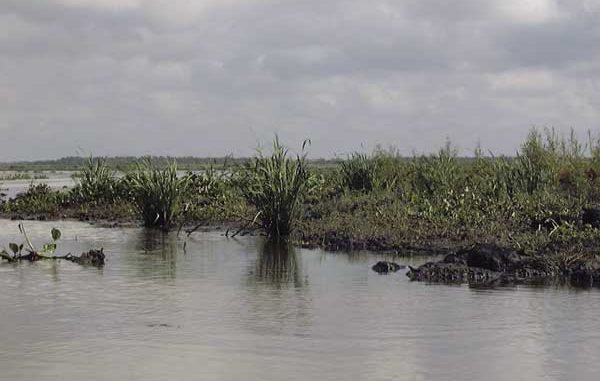
Thanks to another wetland restoration project under construction in south-central Louisiana, the state’s fourth delta is presently being born.
The other three — the Mississippi River, Atchafalaya, and Wax Lake deltas — are certainly older and larger, but the newest, at the “Jaws” in West Cote Blanche Bay, has a tremendous potential for growth.
The Jaws is at the intersection of the Gulf Intracoastal Waterway (GIWW), the Charenton Drainage Ditch and West Cote Blanche Bay. The reason for the tremendous growth potential is that the GIWW is diverting a lot of fresh water from the Atchafalaya River via the Wax Lake Outlet, and with that water comes literally tons of sediment daily, especially during high river stages.
While West Cote Blanche Bay near the Jaws has shoaled significantly in the last few decades, winter storms and other fronts move the sediment around and don’t allow it to stack up to marsh elevations.
Only on the very eastern portion of the project boundary, adjacent to the eastern shoreline of the Jaws, has marsh naturally become established.
The purpose of the wetland restoration project, funded by the Coastal Wetlands Planning, Protection and Restoration Act (CWPPRA), is to create earthen vegetated terraces that will help trap sediment in the northern part of the bay.
To help jump-start the delta formation process, the project is dredging more than 40,000 linear feet of distributary channels to help get the heavier sands out of the navigation channel leading through the Jaws and into shallow-water areas.
The sand and mud dredged during the creation of those distributary channels are being placed in mostly straight lines adjacent to the channels to create marsh terraces. These terraces will help protect mud deposited naturally in the shallow-water areas between the terraces from being lost during storms.
Initial project construction is expected to create more than 60 acres of marsh directly on the terraces, but is also expected to result in more than 1,700 acres of new marsh in the next 20 years as delta growth accelerates due to the construction of the terraces facilitating natural processes.
In addition to moving dirt, the project design calls for the planting of bullwhip and giant cutgrass along the bases of the terraces to help speed vegetative colonization of the dredged material and to protect it from erosion.
However, based on recent observations during construction, such planting efforts may not be necessary. Project construction began in July, and already plants have colonized portions of the older terraces.
Another positive is that construction is going better than expected, and the project is under budget. The soils are stacking to the desired elevations easier than expected, and bids for project, initially expected to cost $2.5 million, were under $1 million.
The savings to the project and CWPPRA program were more than $1.6 million. Those unspent dollars will be returned to the program for use on other projects.
In addition to the large area of wetlands that is expected to be created as a result of this project, local waterfowl hunters should also benefit from the construction of the terraces.
By creating still water conditions between the terraces, it is expected that the coverage of submerged aquatic vegetation (SAV), which already is there to some degree, will become much denser. Most species of SAV that can be expected to be found in the project area are excellent waterfowl food, and ducks should be drawn to the area, just like in the other Louisiana deltas.
Once covered with vegetation, the terraces should make great sites for the location of blinds. Hunters can come in during early morning hours, set out decoys in shallow water adjacent to the terraces, and just use the vegetation on the terraces as a blind.
And because the new delta is on publicly owned waters just a short boat ride down the Charenton Drainage Ditch from Baldwin, accessing the new delta should be free and easy.
Richard Hartman is the leader of the Louisiana Habitat Conservation Division of NOAA Fisheries.


